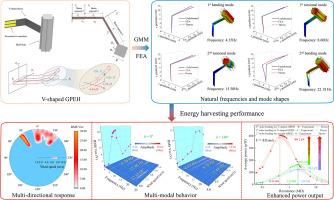一种利用弯曲和扭转模式的v形驰动压电能量采集器
IF 9.4
1区 工程技术
Q1 ENGINEERING, MECHANICAL
International Journal of Mechanical Sciences
Pub Date : 2025-09-16
DOI:10.1016/j.ijmecsci.2025.110841
引用次数: 0
摘要
传统的基于直线光束的能量收集器只能在风来自特定方向时有效运行,这降低了它们在可变自然条件下的效率。本研究提出了一种v型奔腾型压电能量采集器(GPEH),其多模态的触发有助于扩大其有效风向范围。采用全局模态法(GMM)建立了其弯曲模态和扭转模态的理论模型,并通过有限元分析(FEA)对其固有频率和模态振型进行了验证,并通过风洞试验进一步验证。随后,进一步测试了所提出的v型GPEH的输出性能,并证明了它能够通过激活弯曲和扭转模式有效地从多个入射风向收集风能。此外,理论和实验结果都表明,与其他模式相比,在二阶弯曲模式下触发驰动可以获得更高的电压和功率输出。所研制的v型飞奔能量采集器的设计和建模,为在不确定风况的自然环境中捕获气流能量提供了一种有效的策略。本文章由计算机程序翻译,如有差异,请以英文原文为准。

A V-shaped galloping piezoelectric energy harvester exploiting bending and torsional modes
Traditional straight beam galloping-based energy harvesters can only operate effectively when the wind comes from a specific direction, which reduces their efficiency in variable natural conditions. This research proposes a V-shaped galloping-based piezoelectric energy harvester (GPEH) and the triggering of its multiple modes helps broaden its effective wind direction range. A theoretical model is established using the global modal method (GMM) to characterize its bending and torsional modes and verified by finite element analysis (FEA) in terms of natural frequencies and mode shapes and further validated through wind tunnel testing. Subsequently, the output performance of the proposed V-shaped GPEH is further tested and it is demonstrated to be able to effectively harvest wind energy from multiple incident wind directions through the activation of bending and torsional modes. Moreover, both theoretical and experimental results demonstrate that higher electrical voltage and power output are achieved when galloping is triggered in the 2nd order bending mode, compared to other modes. The design and modeling of the developed V-shaped galloping-based energy harvester present an effective strategy for capturing wind flow energy in natural environments characterized by uncertain wind conditions.
求助全文
通过发布文献求助,成功后即可免费获取论文全文。
去求助
来源期刊

International Journal of Mechanical Sciences
工程技术-工程:机械
CiteScore
12.80
自引率
17.80%
发文量
769
审稿时长
19 days
期刊介绍:
The International Journal of Mechanical Sciences (IJMS) serves as a global platform for the publication and dissemination of original research that contributes to a deeper scientific understanding of the fundamental disciplines within mechanical, civil, and material engineering.
The primary focus of IJMS is to showcase innovative and ground-breaking work that utilizes analytical and computational modeling techniques, such as Finite Element Method (FEM), Boundary Element Method (BEM), and mesh-free methods, among others. These modeling methods are applied to diverse fields including rigid-body mechanics (e.g., dynamics, vibration, stability), structural mechanics, metal forming, advanced materials (e.g., metals, composites, cellular, smart) behavior and applications, impact mechanics, strain localization, and other nonlinear effects (e.g., large deflections, plasticity, fracture).
Additionally, IJMS covers the realms of fluid mechanics (both external and internal flows), tribology, thermodynamics, and materials processing. These subjects collectively form the core of the journal's content.
In summary, IJMS provides a prestigious platform for researchers to present their original contributions, shedding light on analytical and computational modeling methods in various areas of mechanical engineering, as well as exploring the behavior and application of advanced materials, fluid mechanics, thermodynamics, and materials processing.
 求助内容:
求助内容: 应助结果提醒方式:
应助结果提醒方式:


